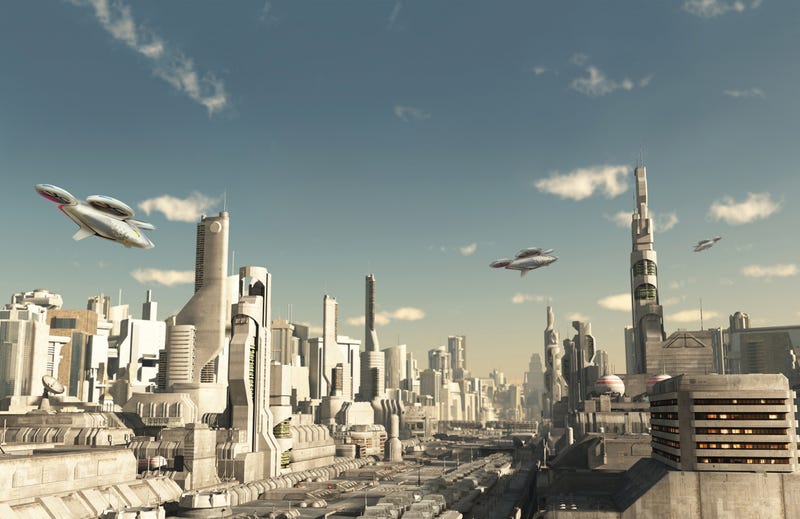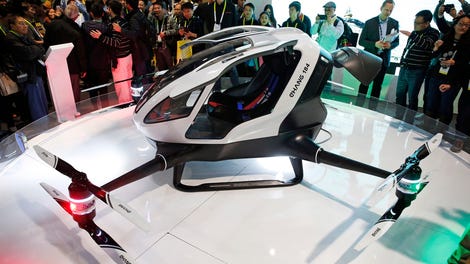You know how some people love to complain that the 21st century is a disappointment because we never got the jet packs and flying cars we were promised? I think the opposite is true.
The 21st century is actually better than anticipated precisely because the Jetsony future dreamt up decades ago has failed to materialize. The real future—meaning our present moment—doesn't look like a thing like those sci-fi images. Instead it's a complex, often confounding hybrid creation of old and new, high tech and low tech, and natural and manmade.
The exact spot where I started thinking about the differences between those timeworn fantasies and what has really transpired is a rooftop in the Brooklyn Navy Yard. It's an old place, established in 1801, and it sits on 300 prime East River waterfront acres where, until 1966, the U.S. Navy built and repaired battleships. Since then it's been an industrial enclave, off limits to the general public, home to manufacturers of everything from artificial sweetener to prefabricated homes to recycled glass countertops.
And lately, like everyplace else in Brooklyn, the Navy Yard has been getting increasingly fashionable, especially the rooftops. One Navy Yard building now has a vineyard on the roof. On another rooftop, construction crews are working on a beer garden and food court for Brooklyn Brewery. Scheduled to open in 2018, it will be the Navy Yard's first major public amenity.
But the Navy Yard rooftop that represents what's great about the 21st century has been, since 2012, a farm. Methodically sown and reaped by a company called Brooklyn Grange, it is a loam-scented acre-and-a half of Swiss chard, Thai basil, and miniature eggplants with a stunning 360-degree view of the surrounding city.
The Navy Yard farm is actually Brooklyn Grange's second operation. The first is an acre atop an industrial building in Long Island City, Queens, built in 2010 with a mixed bag of backing including money raised on Kickstarter. In 2012, with a whopping $600,000 in grant money from New York City's Department of Environmental Protection, funding from a program to mitigate stormwater runoff, they turned the 65,000-square-foot Navy Yard roof into a farm.
The idea that you have to leave the city to make the world a better place now seems obsolete.
On a total of two-and-a-half acres, Brooklyn Grange produces some 50,000 pounds of vegetables a year, most of which are sold directly to restaurants and small greengrocers. The whole endeavor is the antithesis of the back-to-the-land movement of the 1960s; that idea that you have to leave the city to make the world a better place now seems obsolete.
"We wanted to be farmers," explains Gwen Schantz, a founding partner and COO, a veteran of assorted NGOs and food coops (and 2015 Curbed Young Gun). "We wanted to have a farm, and we didn't want to leave our wonderful community and our city that we love so much."
Brooklyn is full of backyard chicken coops and rooftop apiaries. But seeing the sophistication and skill level of the pros makes me think that urban farming as a business and food source will outlive the fad. The Navy Yard roof, on which Brooklyn Grange has a 20-year lease, required some skillful designing and planning, Schantz's specialty.
The bottom layer of a rooftop farm is always a watertight membrane, in this case made of thermoplastic polyoefin, a material with pores too small to allow plant roots to penetrate it "so the plants don't do what they're apt to do," Schantz explains, "and bore right through the roof."
On top of the roof membrane/root barrier, they place "lightweight drainage aggregate" sandwiched between filter fabric and about a foot of Rooflite IntensiveAg blend soil. This is special dirt developed for green roofs, consisting of, according to the Brooklyn Grange website, "mushroom compost for organic nutrients mixed with lightweight, porous stones."


Brooklyn Grange Rooftop Farm. Photo by Anastasia Cole Plakias
Brooklyn Grange recently acquired a sprawling office space on the 11th floor of Building 3, just downstairs from their farm. I stop in the office and walk up to the roof with Schantz and another one of the founders, vice president Anastasia Cole Plakias, author of the recently published What Brooklyn Grange Taught us About Entrepreneurship, Community, and Growing a Sustainable Business.
As we carefully make our way through rows of greenery, Plakias picks a freshly grown coriander berry and hands it to me. I pop it in my mouth, and there's an explosion of cilantro, like I'm eating a homegrown Tic Tac.
Instantly, I'm won over by this fecund rebuke to tar beach that is, in midsummer, overflowing with tomatoes, greens, peppers, and eggplants and buzzing with bees. "The bees love Thai basil," observes Ben Flanner, who joins us.
The layout and variety of the vegetables mimics the density and vitality of the city around it. It is, in a word, diverse.
He's a former industrial engineer and E*Trade analyst who quit his job to grow vegetables on a roof in Greenpoint, a precursor to Brooklyn Grange. He's now the farm's president and director of agriculture. Further along, Plakias hands me a savory leaf from a small cluster of shiso plants, a Japanese herb. I pop it in my mouth and ask whether they sell a lot of shiso.
"It's part of the biodiversity of the farm," says Flanner. "It's not going to make or break us." I chew on my shiso and marvel at the view: the Manhattan skyline, the Williamsburg Bridge, and the glassy towers that are beginning to define this part of Brooklyn.
The farm is strikingly urbane. It's not just that it's on the roof of a World War I-era factory divided by the sawtooth skylights characteristic of the period, but that the layout and variety of the vegetables mimics the density and vitality of the city around it. It is, in a word, diverse.
"In the country you measure farm acreage by the acre. In New York City, we pay rent by the square foot," explains Schantz. "That's an important difference because it affects our financials and it affects how productive we have to be. We're constantly putting pressure on ourselves to produce as much food and as high value food as possible in a short season."
Brooklyn Grange was actually the third rooftop farm enterprise I'd visited over the past few months. In May, I rode 16 miles south from the Chicago Loop (with an Uber driver who was planning to make a fortune selling the design for an omniscient streetlamp to the government of Dubai) to the neighborhood where Pullman railroad sleeping cars were once produced, to visit the world's largest rooftop greenhouse: A 75,000-square-foot facility first seeded in October of last year, and owned and operated by Gotham Greens.
The greenhouse sits atop a newly built Method Soap factory designed by noted green architect William McDonough + Partners. The factory, a gray box decorated with colorful awnings and banners advertising different kinds of cleaning products, is highly water- and energy-efficient and supposedly gets 30 percent of its power from a giant wind turbine that looms over the building. It is, according to McDonough's website, "a model for the clean industrial revolution."
To get to Gotham Greens, I entered from a loading dock at the back of the soap factory. An elevator took me to the roof, where the doors opened onto a nondescript white hallway that smelled overwhelmingly of lettuce. Workers wearing hair nets wheeled giant bins full of salad ingredients.
Gotham Greens began growing produce like butter leaf, arugula, and basil in 2011 in a 15,000-square-foot greenhouse atop an old industrial building in Greenpoint, Brooklyn, and now operates four such facilities, including one atop a Whole Foods in Gowanus, Brooklyn, selling grown-upstairs greens.
"The thesis," Viraj Puri, the company's CEO, tells me, "was why not grow a high quality product in close proximity to this large metropolitan marketplace versus shipping in the product from thousands and thousands of miles away."
That first greenhouse represented their "proof of concept," says Puri. It was "state of the art, very sophisticated. It's got a lot of sensors and computer control systems, advanced irrigation system." The company had been considering setting up a Chicago facility when they were approached by McDonough's firm, who were actively looking for someone to farm the Method roof. The two companies cut a deal that gave Gotham Greens ownership of its facility.
The result is the world's largest rooftop greenhouse, a remarkable sea of pure verdure. Although it's under a transparent polycarbonate roof, the greenhouse evokes a midwestern farm landscape, row after row of one type of plant.
Here the system is hydroponic. Heads of lettuce grow in holes cut in long white metal troughs that carry water and nutrients to the plants. While there are some 50 employees tending and harvesting the greens, the setup is conspicuously technological. If the Jetsons ate lettuce, this is where they'd get it.
Puri, who came to rooftop farming from a background in environmental engineering and solar design, tells me that the setup is far more productive than conventional farming. "In the 75,000 square feet, which is just under two acres, we're producing the yield of an upward of 50 acre farm."
When asked to quantify his company's annual output, Puri says "we're on track to do 20 million heads." Multiply that by the four or five bucks that Gotham Greens products, hermetically sealed in clear plastic boxes, sell for, and you're talking a lot of lettuce.
Puri sees the company's greenhouses as a compliment to conventional field grown crops, not a replacement. Instead, he argues that the biggest impact of a business model he thinks of as "ag-tech" could be on the city itself.

Gotham Greens rooftop farm, Chicago. 
Gotham Greens rooftop farm, Chicago. 
Gotham Greens rooftop farm, Chicago. 
Gotham Greens rooftop farm, Chicago. 
Gotham Greens rooftop farm, Chicago. 
Gotham Greens rooftop farm, Chicago. 
Gotham Greens rooftop farm, Chicago. 
Gotham Greens rooftop farm, Chicago. 
Brooklyn Grange Rooftop Farm. Photo by Anastasia Cole Plakias 
Brooklyn Grange Rooftop Farm. Photo by Anastasia Cole Plakias "We're turning unproductive urban space into productive urban space. It's green. It's living and breathing. It has biodiversity. It reduces the urban heat island effect. It's collecting storm water. It's helping to insulate the buildings upon which we're located."
However, I think Brooklyn Grange may have more of an impact on the city around them than Gotham Greens has. Brooklyn Grange's philosophy is that providing fresh vegetables isn't enough. As Plakias tells me, the "difference between being a farmer and an urban farmer is there's an obligation to bring your farm to the community."
What that means for Brooklyn Grange is that they've spun off a non-profit called City Growers that introduces children to farming. But they also engage the public in other ways, such as renting out their farms for weddings and events and running weekly tours.
They've also become urban farm consultants and designers, applying their skills to other people's rooftops. Schantz now has a general contractor's license and leads a "design and installations" department that builds roof gardens for clients ranging from restaurants like Brooklyn's Meadowsweet to Vice Media.
"Vice asked if we could build them a vegetable garden," Schantz tells me. "I said, 'Why don't we do more than that? We can make a real Garden of Eden.'" Adjacent to Vice's Williamsburg offices in an old sugar factory, Schantz's team wound up installing a 2,000-square-foot vegetable garden plus a 20,000-square-foot meadow.


While the greenhouse is technologically advanced, with sensors monitoring all its functions, the actual farming requires the hands-on skills of some 50 employees.
"Within the first month of having planted it, we started seeing a lot of activity from birds and insects," Schantz recalls. The influx made her curious. How did the butterflies find out about the place?
Through a member of her crew, she found her way to the New School's Urban Ecology department. The New School students then devoted this past spring semester to designing a method for studying rooftop wildlife. Students in coming semesters will actually conduct the study.
Although there's no real data yet, the students' observations have already influenced Schantz's design approach: "The students came back after the first semester and said, 'The insects and the birds need water.' I've never been fond of water features…I always associated them with a frivolous rich person's pleasure garden. But the animals really need it."
Timon McPhearson, the New School associate professor in charge of the study, explains that the typical green roof is a monoculture. They're most often planted with a layer of sedum, a hardy species that can survive almost anything, but, at the same time, doesn't do much to manage storm water or bring the city's ambient temperature down.
But rooftops that are filled with a wide variety of plants, like the Brooklyn Grange farms or the ones Schantz builds for clients, are different. His students, he says, have seen "a lot of visitation by birds who use it as a habitat," meaning they can find food there and gather nesting material. Green roof research, he adds, is now of great interest to a number of universities and also the National Audubon Society. He argues that when you craft a bio-diverse rooftop, you're not just making a pleasant place for the human inhabitants, you're making something that birds and insects recognize as home.
And, for Schantz, at least, the goal is to change the nature of the urban habitat for all concerned. "I feel like what we're doing is part of the food movement," she observes. "But it's also part of the movement to bring green space back into the city and to improve the health of the plants and the animals, but mostly the health of the people here."
Of course, Schantz may be a little too good at building habitats. As we're talking at the Navy Yard, head farmer Matt Jefferson walks by and is drawn into the conversation. Someone asks him describe the differences between Brooklyn Grange's two farms. "The birds are really bad in Queens," he replies. What kind of birds are bad? "Pigeons. They're a real challenge in Queens. They can get a whole bed of seeds overnight. "
The whole idea of Urban Ecology is that cities are an interlocking set of systems that form an environment for humans and also for myriad plants and creatures. It's exciting stuff. We're just beginning to understand how animals adapt to the unnatural surroundings of the city and what happens when we make them more natural.
The Brooklyn Grange crew delights in telling me about kestrel sightings, and the crickets they hear on the Navy Yard roof, and the fact that the bees they raise are healthier than rural bees. But the pigeons are another story. They are hardcore city dwellers.
They likely know more about Urban Ecology than anyone at the New School. And like all true New Yorkers, they are opportunists. "The pigeons are real, real bad," Jefferson complains, "and they don't care."
Source:
The farm upstairs












 About The Time the Flying Car and Inventions Around Us by Aleksandr Anufriyev:
About The Time the Flying Car and Inventions Around Us by Aleksandr Anufriyev: The full production PAL-V Liberty will be unveiled in early 2017.
The full production PAL-V Liberty will be unveiled in early 2017. SEE ALSO: Is Toyota Working on a Ridiculous Flying Car?
SEE ALSO: Is Toyota Working on a Ridiculous Flying Car? The company claims that this makes it easier to f ly and safer too, as this type of plane cannot stall and is affected less by cross winds. In fact, the PAL-V is said to experience only 20 percent of the turbulence a comparable fixed wing plane would feel. A special license is required to fly the PAL-V which takes between 30 and 40 hours to complete.
The company claims that this makes it easier to f ly and safer too, as this type of plane cannot stall and is affected less by cross winds. In fact, the PAL-V is said to experience only 20 percent of the turbulence a comparable fixed wing plane would feel. A special license is required to fly the PAL-V which takes between 30 and 40 hours to complete. Photo credit: Airbus Group
Photo credit: Airbus Group  A CityAirbus vehicle. Photo credit: Airbus Group
A CityAirbus vehicle. Photo credit: Airbus Group  Oh Look, Our Long Awaited Flying Car Is Almost Here Maybe
Oh Look, Our Long Awaited Flying Car Is Almost Here Maybe  Larry Page Has Been Secretly Investing in Flying-Car Start-Ups
Larry Page Has Been Secretly Investing in Flying-Car Start-Ups  Is This the Autonomous Flying Taxi of Our Dreams?
Is This the Autonomous Flying Taxi of Our Dreams? 











 Craig Webster landed the air ambulance in a pay and display car park (Picture: SWNS)
Craig Webster landed the air ambulance in a pay and display car park (Picture: SWNS)  He put 60p in the machine (Picture: SWNS)
He put 60p in the machine (Picture: SWNS)  Hundreds stage Sainsbury's 'kiss-in' after gay couple 'kicked out for holding hands'
Hundreds stage Sainsbury's 'kiss-in' after gay couple 'kicked out for holding hands'  Police 'witness paranormal events' at family home including 'dog levitating onto hedge'
Police 'witness paranormal events' at family home including 'dog levitating onto hedge'  Urgent search for missing schoolgirl, 13, who may have travelled abroad
Urgent search for missing schoolgirl, 13, who may have travelled abroad  Brexit 'will be delayed until 2019'
Brexit 'will be delayed until 2019'  Prison officer facing jail for lesbian affair with inmate
Prison officer facing jail for lesbian affair with inmate 



